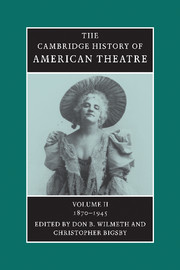Book contents
- Frontmatter
- Introduction
- Timeline: Post-Civil War to 1945
- 1 The Hieroglyphic Stage: American Theatre and Society, Post-Civil War to 1945
- 2 A Changing Theatre: New York and Beyond
- 3 Plays and Playwrights
- 4 Theatre Groups and Their Playwrights
- 5 Popular Entertainment
- 6 Musical Theatre
- 7 Actors and Acting
- 8 Scenography, Stagecraft, and Architecture
- 9 Directors and Direction
- Bibliography
- Index
1 - The Hieroglyphic Stage: American Theatre and Society, Post-Civil War to 1945
Published online by Cambridge University Press: 28 March 2008
- Frontmatter
- Introduction
- Timeline: Post-Civil War to 1945
- 1 The Hieroglyphic Stage: American Theatre and Society, Post-Civil War to 1945
- 2 A Changing Theatre: New York and Beyond
- 3 Plays and Playwrights
- 4 Theatre Groups and Their Playwrights
- 5 Popular Entertainment
- 6 Musical Theatre
- 7 Actors and Acting
- 8 Scenography, Stagecraft, and Architecture
- 9 Directors and Direction
- Bibliography
- Index
Summary
Introduction: Death, Fire, and Wizards
EDITH WHARTON: In reality they all lived in a kind of hieroglyphic world, where the real thing was never said or done or even thought, but only represented by a set of arbitrary signs.
The Age of Innocence (1920)WILL ROGERS (on the death of Florenz Ziegfeld): To have been the master amusement provider of your generation, surely a life’s work has been accomplished.
The Autobiography of Will Rogers (1935)VACHEL LINDSAY: …the wizards should rule, and the realists should serve them.
The Art of the Moving Picture (1915).Inside and Outside Of the Playhouse
The period of American theatrical entertainment to be surveyed here covers approximately three-quarters of a century, beginning in 1870 – though I will actually reach back to 1865 as my starting point – and ending in 1945. It is a rich, complex era of theatrical developments and transformations. During these decades American entertainment became one of the largest industries in the country, encompassing not only dramatic performances and musical theatre (from revues to opera) but also minstrelsy, vaudeville, amusement arcades and parks, circuses, and the new media of film and radio. In this chapter some of the defining traits of this broad array of entertainment will be outlined, and American theatre will be situated within the context of American cultural history (the political, economic, social, moral, and artistic aspects of the time). The events and conditions of the period serve as both a catalogue of the defining traits of American life and a measure of the theatre’s accomplishments.
Typically, when dividing history into epochs, the beginning and the end of a period are identified by means of major events, including decisive wars and the deaths of important people. In the case of American history between 1865 and 1945, the deaths of two presidents, Abraham Lincoln and Franklin Delano Roosevelt, coincide with the culmination of two major wars and thus provide convenient and fitting period markers. The deaths also serve as points of transition between what has been and what will be, momentary gaps in the march of history.
- Type
- Chapter
- Information
- The Cambridge History of American Theatre , pp. 107 - 195Publisher: Cambridge University PressPrint publication year: 1999
- 3
- Cited by



